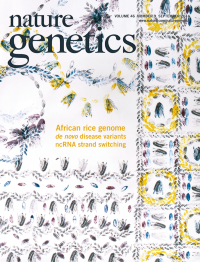Ver ítem
- xmlui.general.dspace_homeCentros e Institutos de InvestigaciónCICVyA. Centro de Investigación en Ciencias Veterinarias y AgronómicasInstituto de BiotecnologíaArtículos científicosxmlui.ArtifactBrowser.ItemViewer.trail
- Inicio
- Centros e Institutos de Investigación
- CICVyA. Centro de Investigación en Ciencias Veterinarias y Agronómicas
- Instituto de Biotecnología
- Artículos científicos
- Ver ítem
The genome of the stress-tolerant wild tomato species Solanum pennellii
Resumen
Solanum pennellii is a wild tomato species endemic to Andean regions in South America, where it has evolved to thrive in arid habitats. Because of its extreme stress tolerance and unusual morphology, it is an important donor of germplasm for the cultivated tomato Solanum lycopersicum1. Introgression lines (ILs) in which large genomic regions of S. lycopersicum are replaced with the corresponding segments from S. pennellii can show remarkably superior
[ver mas...]
Solanum pennellii is a wild tomato species endemic to Andean regions in South America, where it has evolved to thrive in arid habitats. Because of its extreme stress tolerance and unusual morphology, it is an important donor of germplasm for the cultivated tomato Solanum lycopersicum1. Introgression lines (ILs) in which large genomic regions of S. lycopersicum are replaced with the corresponding segments from S. pennellii can show remarkably superior agronomic performance2. Here we describe a high-quality genome assembly of the parents of the IL population. By anchoring the S. pennellii genome to the genetic map, we define candidate genes for stress tolerance and provide evidence that transposable elements had a role in the evolution of these traits. Our work paves a path toward further tomato improvement and for deciphering the mechanisms underlying the myriad other agronomic traits that can be improved with S. pennellii germplasm.
[Cerrar]

Autor
Bolger, Anthony;
Scossa, Federico;
Bolger, Marie E.;
Lanz, Christa;
Maumus, Florian;
Tohge, Takayuki;
Quesneville, Hadi;
Alseekh, Saleh;
Sørensen, Iben;
Lichtenstein, Gabriel;
Fich, Eric A.;
Conte, Mariana;
Keller, Heike;
Schneeberger, Korbinian;
Schwacke, Rainer;
Ofner, Itai;
Vrebalov, Julia;
Xu, Yimin;
Osorio, Sonia;
Aflitos, Saulo Alves;
Schijlen, Elio;
Jiménez-Goméz, José M.;
Ryngajllo, Malgorzata;
Kimura, Seisuke;
Kumar, Ravi;
Koenig, Daniel;
Headland, Lauren R.;
Maloof, Julin N.;
Sinha, Neelima;
van Ham, Roeland C. H. J.;
Lankhorst, René Klein;
Mao, Linyong;
Vogel, Alexander;
Arsova, Borjana;
Panstruga, Ralph;
Fei, Zhangjun;
Rose, Jocelyn K. C.;
Zamir, Dani;
Carrari, Fernando;
Giovannoni, James J.;
Weigel, Detlef;
Usadel, Björn;
Fernie, Alisdair R.;
Fuente
Nature Genetics 46 (9) : 1034-1039 (Septiembre 2014)
Fecha
2014-09
Editorial
Nature Publishing Group
ISSN
1546-1718
Formato
pdf
Tipo de documento
artículo
Palabras Claves
Derechos de acceso
Abierto
 Excepto donde se diga explicitamente, este item se publica bajo la siguiente descripción: Creative Commons Attribution-NonCommercial-ShareAlike 2.5 Unported (CC BY-NC-SA 2.5)
Excepto donde se diga explicitamente, este item se publica bajo la siguiente descripción: Creative Commons Attribution-NonCommercial-ShareAlike 2.5 Unported (CC BY-NC-SA 2.5)


